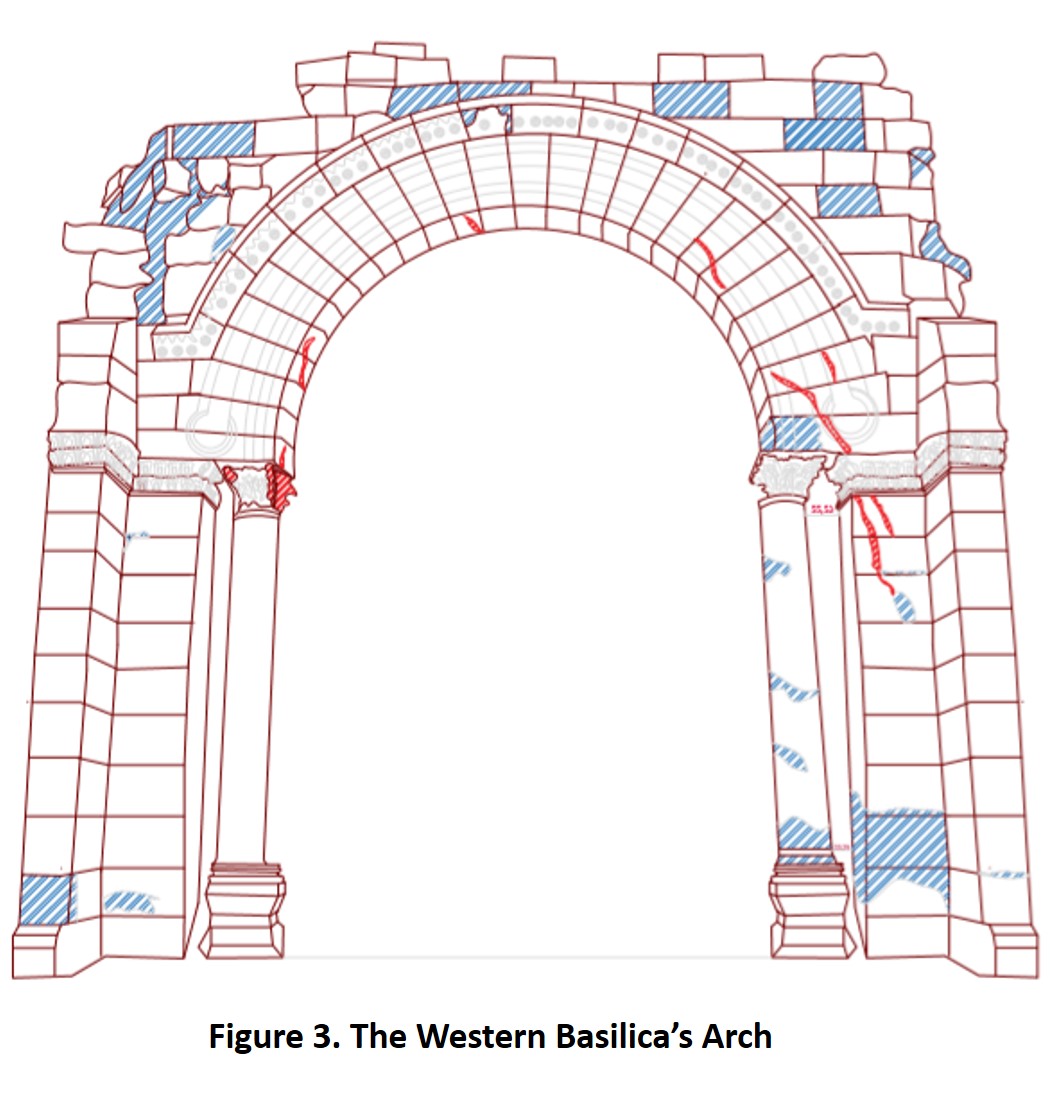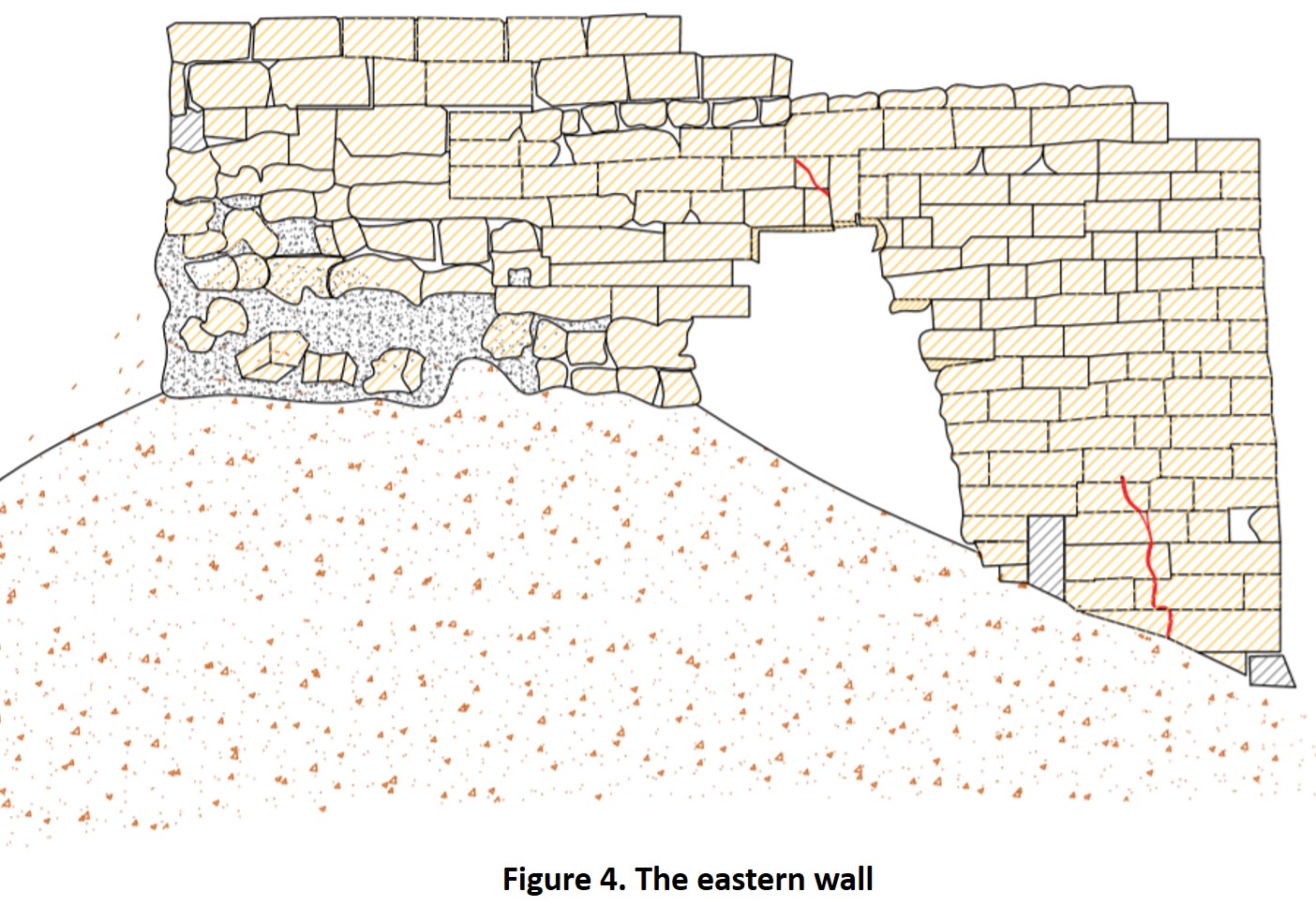By: Ammar Kannawi
Translated by: Rim Lababidi
The Monastery of Saint Simon is located in the northern side of the Limestone Massif, around 35 km west of Aleppo city. The complex was named after Saint Simon the Stylites, and in 2011, it was listed along with several other adjacent archaeological sites on the World Heritage Sites List of UNESCO. The Monastery of Saint Simon is considered one of the most significant monuments from the Byzantine period in Syria. It includes a church of a cross plan that was built around the remaining parts of the pillar of St. Simon. The church also includes a baptistery for adults and another one for children in addition to several other buildings that were dedicated to serving the pilgrims. Surrounding walls were built around the complex at the start of the 6th century A.D., probably to prevent potential attempts of violations or theft. Until the 10th century A.D., there had been no alternations to these surrounding walls.
Several international expeditions worked on the site, and starting from the middle of the 20th century, the complex was subject to subsequent conservation projects which methods and techniques differed according to the period when they were applied at.
Since the start of the Syrian war, the Monastery of St. Simon has been exposed to different types of damage. It was used as a military base and later as a military-training camp, and at some point of the war, the monastery became a major frontline. In 2016, an air campaign targeted the church and destroyed the pillar of St. Simon.
Recently, we were able to document the condition of the site and we are currently in the process of assessing the damage affecting its structural elements. So far, three elements have been identified that are in need of urgent stabilization measures.
- The structural damage:
In 2019, SIMAT association and in collaboration with the Idlib Antiquity Center conducted several documentation processes that detected and documented all the natural and man-made hazards affecting the Monastery of St. Simon. Currently, a work plan is being developed that aim at documenting the current condition of the site, assessing the damage affecting it, and implementing an emergency intervention to stabilize its most vulnerable structural elements that threatens the stability of the monastery. Additionally, a temporary protection will be applied to some of the architectural and ornamental elements of the site, and the surrounding of the site will be explored.
This report presents a comprehensive explanation for the structural damage affecting the monastery that requires an urgent response.

- The western surrounding wall:
The western surrounding wall of the monastery is a double-layer wall that was built of carved lime blocks of irregular size, and no mortar was used to bind the blocks together. The wall does not have defensive towers, nor does it have buttresses, and it directly rests on a rocky slop of hard lime stones that extends towards the west.
At the end of last winter, the wall suffered a partial collapse that formed a gap of around 17m.

- Reasons of the collapse:
The reasons behind the collapse remain under investigation.
Given that the western part of the wall is built on the edge of a cliff, the external elevation of the wall rises up to 6m, while its inner elevation remains subterranean as the ground of the monastery is at the level of the top of the wall. It is possible that this difference between the two sides of the wall created a pressure that led to its collapse. The presence of olive trees close to the wall might be another factor why the wall collapsed as their roots extend between the blocks of the wall.

Another possible reason behind the collapse is the previous conserva
tion processes that were imple

mented through different times of history. It is very likely that the intervention had created weak points in the wall. For example, the conservation work that was conducted in the 1960s had resulted with a fall back in the elevation of the wall at its northern side, which is close to the collapsed
part of the wall.
Damage assessment:
The partial collapse in the wall, which was probably caused by natural hazards threatens the integrity of the rest of the wall. It is most likely that the bond between the lime blocks of the wall is weakened due to the collapse, a factor that could eventually lead to a structural failure in the wall. Furthermore, the water resulting from rainfall will penetrate the edges of the wall around the gap, which will furtherly weakens these edges. Similarly, the water will penetrate the two layers of the wall, a factor that may impose tremendous pressure on the exterior side of the wall.

- 2- The arch of the western basilica:
It is the western church of the intersecting churches. Only the eastern arch of the church that connected it to the octagonal body carrying the dome above the pillar of St. Simeon is still standing today. This arch is carried on two cylindrical columns with Corinthian crowns, adjacent to them two buttresses that help to carry the arch as well.
The southern column tilts around 20cm to the north of the body of the buttress and its crown. The crown of the northern column on the other hand has been damaged in 2016 by the aerial bombing, which led to splitting the crown in two halves and fragmenting one of them.

Damage Assessment:

It is feared that the crown of the northern column is too weak to endure the impact of weathering. In case of collapsing other parts of the crown, the arch will be prone to collapsing, especially, with the existing cracks in the blocks of the arch and the adjacent buttresses, and the continuation of the military operations around the site.

- The northern part of the eastern wall located at the current entrance of the complex:
For an estimated distance of 15m, the eastern wall veers off its original path towards the west. The part of the wall that is under study is located at the start of this deviation with its façade facing south. This part of the eastern wall stands on a mild slope, which makes the eastern side of its foundations visible. These foundations consist of random stones and backfill, while the wall itself consist of irregular blocks, some of which were reused. The blocks of the exterior elevations were bind together using mortar. At the corner, a previous conservation work can be seen where reused blocks were irregularly laid down. The wall consist of two courses of blocks in the lower part and one course of blocks in its upper side.
There is a recent hole in the wall that extends from the ground up to the middle of its elevation. It is unknown whether this hole was the result of a natural hazard or a man-made one.

- Damage Assessment:

The identified hole puts that part of the wall at risk of collapsing given that the remaining section of the wall above the hole is no longer supported. This specific part of the remaining wall consists of four courses of single-layer blocks that used to be held on the collapsing part. The mortar binds the courses together, however, it is most likely that it will not be able to resist the pressure for a long time. During the assessment we also noticed that the foundations are relatively weak, especially, with the existence of several cracks across the eastern elevation.

Conclusion:
This report aims to indicate the damage affecting the structural elements of the Monastery of St. Simon’s that are in need of urgent intervention. A comprehensive study is being developed, in collaboration with conservators specialized in emergency response to damaged cultural heritage. The emergency response to the damage affecting the site is part of a comprehensive project that aims to document the current condition of the archaeological site and to preserve it.
Preparing diagrams for the damages on the archaeological sites were achieved by Abdulslam Alhmoo

